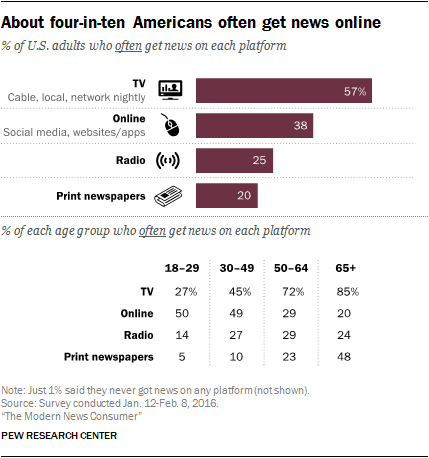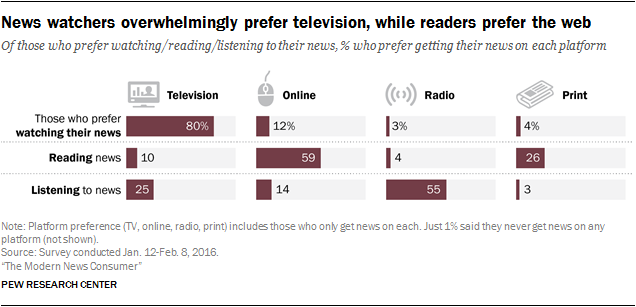In 2016, Americans express a clear preference for getting their news on a screen – though which screen that is varies. TV remains the dominant screen, followed by digital. Still, TV news use is dramatically lower among younger adults, suggesting further shake-ups to come.

- As of early 2016, just two-in-ten U.S. adults often get news from print newspapers. This has fallen from 27% in 2013.
- This decrease occurred across all age groups, though the age differences are still stark: Only 5% of 18- to 29-year-olds often get news from a print newspaper, whereas about half (48%) of those 65 and older do.
- Compared with print, nearly twice as many adults (38%) often get news online, either from news websites/apps (28%), on social media (18%) or both. (81% of adults ever get news on these online platforms.)
- Still, TV continues to be the most widely used news platform; 57% of U.S. adults often get TV-based news, either from local TV (46%), cable (31%), network (30%) or some combination of the three. This same pattern emerges when people are asked which platform they prefer – TV sits at the top, followed by the web, with radio and print trailing behind.
- But demographics speak to the fragility behind those TV numbers. While solid majorities of both those ages 50-64 (72%) and those 65+ (85%) often get news on TV, far smaller shares of younger adults do so (45% of those 30-49 and 27% of those 18-29). Alternatively, the two younger groups of adults are much more likely than older adults to turn to online platforms for news – 50% of 18- to 29-year-olds and 49% of those ages 30-49 often do so.
TV’s staying power over print is buttressed by the fact that Americans who prefer to watch news still choose TV, while most of those who prefer to read the news have migrated online.

- The greatest portion of U.S. adults, 46%, prefer to watch news rather than read it (35%) or listen to it (17%).
- When paired with the platforms people prefer, the data reveal that as of now, the web has largely pulled in “readers” rather than “watchers.” While those who prefer watching news predominantly opt for TV and listeners turn to radio, most of those who prefer reading news now opt to get news online rather than in print (59%, compared with 26% of news readers who opt for print).
Within the digital realm, mobile news consumption is rising rapidly. The portion of Americans who ever get news on a mobile device has gone up from 54% in 2013 to 72% today.

- Two-thirds, 66%, of adults get news on both types of digital devices, while 13% get news only on a desktop/laptop and 5% only do so on a mobile device (15% do not get news on any digital device).
- But, among those who get news on both, more prefer mobile (56% to 42% who prefer desktop).
- One of the most prominent distinctions between those oriented towards mobile devices for their digital news and those oriented towards desktops is age. Fully seven-in-ten of those ages 18-29 either prefer or only use mobile for getting their digital news, compared with 53% of those 30-49, 29% of those 50-64 and just 16% of those 65+. When it comes to news attitudes and habits, the two groups are quite similar. This includes loyalty to news sources, trust in information from news organizations, discussion of news with others and level of engagement with news on social media.
Personal contacts are also a common source of news and can play an amplified role online. But Americans see clear distinctions between news organizations, friends and family, and more distant individuals.

- About two-thirds (63%) of Americans say family and friends are an important way they get news, whether online or offline; 10% see them as the most important.
- Still, online news organizations play the larger role: 36% of online news consumers often get news from news organizations, compared with about half as many who do so from people with whom they are close (15%). Even fewer (6%) say they often get news from people they’re not close with.
- But those who get news from these sources are as likely to say the news from close friends and family is relevant as they are to say this of news organizations; 15% of those who get online news from close personal contacts say those updates are very near to their interests, compared with 11% who get news from news organizations and 4% of those who get news from more distant contacts.
- The less newsy are more likely to say friends and family are important pathways to news: 69% of those who follow news less often say friends and family are important, compared with 57% of those who follow news all or most of the time. Additionally, women are more likely than men to say friends and family are important, young adults are more likely than older adults, and blacks are more likely than whites to say this.




